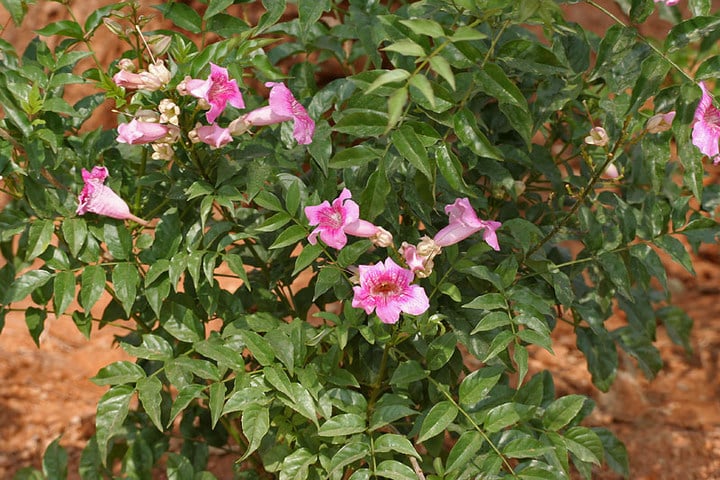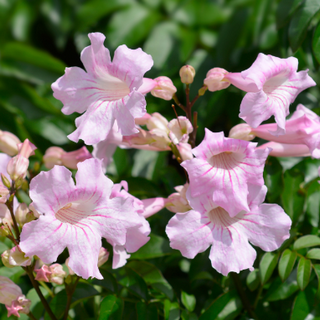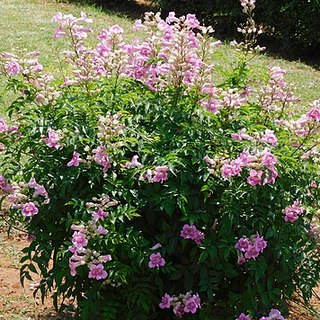Pink trumpet vine is a sprawling, tropical-looking plant with bubble gum pink flowers. It can be grown as a shrub, vine, or ground cover depending on how it’s pruned and supported. Here’s everything you need to know about growing this versatile South African native.

Pink trumpet vine (Podranea ricasoliana) is a beautiful plant that can be whatever you want it to be. Unlike most vines, it doesn’t have the means to climb on its own, making it more of a scrambler than a climber. So depending on how you trim and support this flexible plant, you can grow it as a vine, shrub, or ground cover.
Its showy, slightly fragrant pink flowers are ruffled and petunia-like and really pop against glossy, dark green leaves.
Plants are extremely vigorous in subtropical regions, but in the desert, this plant is generally well-behaved. Additionally, it tends not to produce many seeds so it doesn’t reseed aggressively in desert gardens.
Its trumpet-shaped flowers attract bees and hummingbirds.
Why I Like This Plant
- Large, bubblegum pink flowers
- Glossy evergreen leaves
- Low maintenance
- No thorns, not toxic
- Attracts bees, hummingbirds
Things to Watch Out For
Pink trumpet vine doesn’t twine or have tendrils or aerial rootlets. If you want it to climb, you will need to tie the branches to a support structure such as a pergola, trellis, fence, or arbor. This can be an unexpected and unwelcome task. But this plant is so pretty, you may not mind.
Optimal Growing Conditions
If you’re thinking of adding a pink trumpet vine to your garden, you need to find a suitable place that will keep it healthy and looking good… while minimizing maintenance for you.
Here are the key factors to keep in mind.
Temperature
Pink trumpet vine should be grown in USDA Hardiness Zones 9 – 11. It tolerates heat, but blooms in the spring and fall, typically taking a pause from blooming during the heat of the summer.

It’s evergreen in mild climates and semi-deciduous in areas that have winter freezes. It loses its leaves when the temperature dips below 25℉, but survives temperatures as low as 10℉.
Sun Exposure
Pink trumpet vine can be grown in full sun to part shade, but it blooms most profusely in full sun. However, it’s best not to plant it along a west-facing wall — the hottest spot in the garden — unless it gets some afternoon shade. But when plants get too much shade, they get leggy.
Size and Growth Rate
It’s a fast grower that typically reaches a size of 10 feet wide and 20 feet tall unless you control its size with pruning, or you prune it to grow as a shrub.

Soil
Pink trumpet vine can be grown in any native soil, provided it’s well-draining but, it prefers fertile soil.
Other Location Considerations
Since its growth habit is vine-like, an ideal spot is along a wall where it will get some support. (But don’t make that a hot, sunny, west-facing wall.)
Pink trumpet vine stems root wherever they touch the soil, making it a good spreading ground cover for slopes.
Pink Trumpet Vine:
The Essentials
| Common Name | Pink trumpet vine |
| Scientific Name | Podranea ricasoliana |
| Origin | Africa |
| Plant Type | Semi-deciduous vine, shrub, ground cover |
| USDA Zones | Zones 9 – 11 |
| Cold Hardiness | To 10℉ |
| Flower Color | Pink |
| Flower Season | Spring, fall |
| Mature Size | 20’ high x 10’ wide |
| Growth Rate | Fast |
| Sun Tolerance | Full, part sun |
| Water Needs | Moderate |
| Pests & Diseases | None |
| Garden Friendly | No thorns, non-toxic |
| Wildlife | Attracts bees, hummingbirds |
How to Plant
The rule of thumb when planting any vine in the desert is to dig a hole three times as wide as the root ball but no deeper. Since it prefers fertile soil, consider amending your hole with compost or a commercial soil mix. And if your soil is slow draining, and add sand or small gravel.
Top with organic mulch rather than gravel, which helps to retain moisture and increase soil fertility.
When to Plant
The best time to plant pink trumpet vine is in the fall. This gives it three seasons to grow roots and get established before the following summer.
The second best time is in spring, the earlier the better. This still gives your plant time to get established before the intense heat of June arrives.
How to Care for Pink Trumpet Vine
Whether you’ve recently planted a pink trumpet vine or have an existing plant in your yard, here’s how to take care of it to keep it healthy and looking its best.
How to Water New Plants
Once you’ve got your pink trumpet vine in the ground, watering is your most immediate concern. Here is the recommended watering schedule for new vines planted in the spring or fall.
| Weeks 1 & 2 | Every 3 – 4 days |
| Weeks 3 & 4 | Every 6 – 7 days |
| Weeks 5 & 6 | Every 7 – 10 days |
| Weeks 7 & 8 | Every 10 – 14 days |
After week 8, gradually revise your watering schedule, depending on the season.
How to Water Established Plants
Here’s a suggested watering schedule for subsequent years.
| Spring & Fall | Every 10 – 14 days |
| Summer | Every 7 – 10 days |
| Winter | Every 14 – 21 days |
Pink trumpet vine prefers consistently moist soil, but is somewhat drought tolerant once established.
Should You Fertilize?
Since pink trumpet vine did not evolve to grow in our desert southwest soil and is a prolific bloomer, it benefits from an application of fertilizer in the spring. You can further increase soil fertility by top dressing with compost or organic mulch a few times per years.
How to Prune
This versatile plant can be pruned into just about any shape you want.
On one extreme, it can be trained to grow as a hedge or espalier. On the other, you can let it sprawl unsupported as a ground cover.
But most people grow it as a vine that grows alongside a garden wall or next to a trellis or other supporting structure.
Prune it in early spring to remove cold damage or dead, woody branches.
You can lightly prune it any time to control its size and shape.
Once established, pink trumpet vine benefits from hard pruning, i.e., cutting it back to one foot in early spring every few years. This invigorates the plant and encourages flowering.
Don’t Confuse Pink Trumpet Vine With…
Pink trumpet vine (Podranea ricasoliana) is often confused with bower vine (Pandorea jasminoides). Both are evergreen vines with glossy leaves and pink flowers that have similar care requirements.
And weirdly, their genus names — Podranea vs Pandorea — are anagrams!

Plant Lover Facts
The scientific consensus is that pink trumpet vine is native to southern and southeastern Africa.
However, many South African botanists suspect that it may not be indigenous to southern Africa and was introduced there by slave traders. But it is so widely grown throughout the world, that it may prove difficult to find its true origin. It has now naturalized throughout Mexico, Central America, and in the Mediterranean regions of southern Europe and northern Africa.
Did you enjoy this article?
Sign up for our weekly newsletter
where you’ll find more great info on creating &
maintaining a beautiful, carefree desert landscape.
Author Bio
Deane Alban is the creator of Southwest Gardener. She is a science writer with a bachelor’s degree in botany from the University of South Florida. Gardening is her lifelong passion. She’s been gardening in Tucson for over 15 years.

